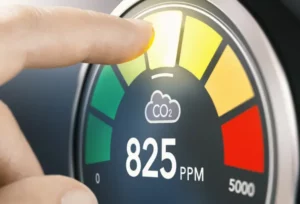It is undeniable that the state of the environment on our planet is becoming concerning. It needs to be addressed as urgently as possible.
Where do we even begin? Freshwater sources are shrinking, the air quality is worsening, our soil is getting polluted, and literally every resource available that gives us life is getting damaged. It is more than obvious that we need sustainable solutions in all industries and aspects of life.
Fortunately, there’s a promising new material that could be groundbreaking in creating a greener future. It’s called Graphene.
What people are calling the “wonder material” is just a single atom thick, yet, it’s 200 times stronger than steel.
With such revolutionary properties, graphene is emerging as a powerful element that could enable graphene sustainability. It offers great potential for clean tech applications.
In this piece, we’ll explore the incredible benefits graphene has to offer and how it could help shape a more eco-friendly, livable world for all of us.
Graphene Sustainability for Clean Water and Sanitation
The global water crisis is one of the most pressing issues of our time, with millions lacking access to safe drinking water.
While water filtration systems exist, many contaminants prove difficult to remove using conventional technologies.
However, graphene’s unique atomic structure, which resembles a honey-comb lattice, allows it to act as an ultra-efficient sieve for removing even the smallest water pollutants, like heavy metals and organic molecules.
Renewable Energy Generation and Storage
As the world transitions from fossil fuels to renewable sources like solar and wind, energy storage solutions are critical to ensuring a consistent, reliable supply.
Graphene is poised to be a game-changer in this arena, as it can significantly improve the performance of solar cells, batteries, and supercapacitors.
Applied as an electrode in lithium-ion batteries, graphene enables faster charging and higher storage capacity – characteristics demonstrated by researchers who created a graphene-based battery that charged in just 16 seconds!
Graphene-enhanced supercapacitors also show remarkable potential for energy storage, with prototypes exhibiting power densities 100 times greater than lithium batteries.
From solar farms to electric vehicles and smart grids, the integration of graphene promises to supercharge the renewable energy revolution.
Sustainable Materials and Manufacturing
Beyond energy, graphene’s unique strength-to-weight ratio and versatility position it to radically reduce the environmental impacts of manufacturing processes and products across numerous industries.
By adding even a small amount of graphene, materials like concrete, rubber, and plastics can gain significant durability and longevity, reducing consumption and waste.
For example, researchers at the University of Exeter found that mixing graphene into concrete nearly doubled its strength, meaning less material is needed for comparable performance.
Similarly, contributing graphene sustainability, its coatings are being applied to metal piping and equipment to prevent corrosion, dramatically extending product lifespans and reducing replacement rates.
Environmental Monitoring and Remediation with Graphene Sustainability
Acute awareness of environmental issues like air and water pollution hinges on robust monitoring and detection capabilities.
Graphene’s conductivity properties make it exceptionally proficient at sensing even minute levels of pollutants.
In Barcelona, researchers deployed graphene-based sensors that detected harmful nitrogen dioxide—a byproduct of fossil fuel combustion—with unprecedented accuracy down to ultralow concentrations.
Furthermore, graphene can catalyze chemical reactions to break down pollutants like plastics and dyes into harmless byproducts, unlocking new possibilities for environmental remediation.
For example, graphene-coated membranes could filter out microplastics from wastewater, helping mitigate the growing issue of plastic pollution in marine ecosystems.
Graphene for Sustainable Transportation
Another major frontier for graphene’s sustainability contributions is transforming transportation systems toward more eco-friendly solutions.
In the automotive industry, graphene is being incorporated into battery technologies for electric vehicles (EVs) to increase energy density and charging speeds.
For example, researchers at Northwestern University developed a graphene-enabled lithium-ion battery with vastly superior performance compared to traditional EV batteries.
Their graphene batteries could fully charge in just 15 minutes and had over triple the life cycle before degrading.
Looking beyond EVs, graphene also shows promise for reducing emissions from traditional combustion engines.
When added to engine oil formulations, graphene nanoparticles can significantly reduce friction and heat generation, thereby boosting fuel efficiency and cutting harmful emissions like nitrogen oxides.
Aerospace companies are also exploring ultra-lightweight graphene composites that could reduce fuel consumption for airplanes and rockets.
And in the rail industry, graphene-reinforced materials are being tested for their potential to create more durable, resilient infrastructure like rails and railroad ties.
Overall, graphene has the potential to drive sustainability advances across all transportation modes – enhancing electrification while also optimizing existing technologies for reduced environmental impacts.
Continued R&D could enable a new generation of “greener” transportation powered by graphene.
Graphene for a Circular Economy. Is it Sustainable?
Underpinning many of graphene sustainability opportunities is its ability to foster a more circular economic model that prioritizes reducing waste and reusing/repurposing materials.
Graphene’s ultra-strength allows products and infrastructure to have vastly longer lifespans, delaying the need for replacements.
Additionally, graphene can imbue recyclability to traditionally hard-to-recycle materials.
For example, researchers have demonstrated using graphene to create recyclable silicon products like solar cells, batteries, and consumer electronics.
In these devices, introducing graphene into the silicon semiconductor prevents it from degrading under thermal cycling, enabling components to be more easily recovered and reused after the product’s life cycle.
Graphene’s conductive properties can also facilitate easier recycling methods for materials like rubber and concrete by using electric pulses to more effectively separate components for reuse.
There are even explorations around “graphene-recovering” and reusing graphene itself from spent products through chemical processes, creating a closed recycling loop.
By extending product life cycles and material reusability across industries, graphene provides an avenue toward the truly circular, zero-waste economy that is crucial for long-term sustainability.
Fully realizing graphene’s potential could disrupt “take-make-waste” economic norms in favor of a regenerative model that maximizes resource efficiency.
Beyond the applications discussed, graphene is being explored for sustainable agriculture via nutrient-rich fertilizers and highly sensitive crop monitoring.
There is also immense potential for graphene solutions in green construction, smart city infrastructure, and much more.
However, key challenges include optimizing scalability and reducing production costs to accelerate widespread adoption.
Complex regulations around new materials like graphene also create compliance hurdles.
With graphene’s sustainability promise capturing attention worldwide, the coming decade will likely see graphene-enabled technologies penetrate global markets, fostering a sustainable revolution.
So, is Graphene Sustainable?
As covered, graphene has incredible innovative properties. It can power renewable energy grids, purify water sources, and even reduce industrial waste. Across multiple parts of industries, graphene can be revolutionary.
This element is powerful and helps tackle the most pressing environmental issues. Its applications are diverse.
Researchers in academic labs and R&D departments are working on unlocking new ways to use graphene. The element could bring about a global shift in terms of sustainability. No wonder it’s called the “wonder material”.
Like with any new development in science, there are challenges to overcome. However, with climate change threats increasing with every passing year, the incentive to develop a solution is becoming more important.
Graphene promises to be a cost-effective and scalable solution. It can be a catalyst for change and foster a real breakthrough.
The potential of this new discovery is incredibly exciting.





